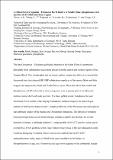Files in this item
A refined late-Cryogenian – Ediacaran Earth history of South China: : phosphorous-rich marbles of the Dabie and Sulu orogens
Item metadata
| dc.contributor.author | Prave, A. R. | |
| dc.contributor.author | Meng, F. | |
| dc.contributor.author | Lepland, A. | |
| dc.contributor.author | Kirsmäe, K. | |
| dc.contributor.author | Kreitsmann, T. | |
| dc.contributor.author | Jiang, C. Z. | |
| dc.date.accessioned | 2018-12-02T00:48:29Z | |
| dc.date.available | 2018-12-02T00:48:29Z | |
| dc.date.issued | 2018-02 | |
| dc.identifier | 251679906 | |
| dc.identifier | 44131702-f6cd-46b4-8226-fcdb1c684003 | |
| dc.identifier | 85037860377 | |
| dc.identifier | 000424176100011 | |
| dc.identifier.citation | Prave , A R , Meng , F , Lepland , A , Kirsmäe , K , Kreitsmann , T & Jiang , C Z 2018 , ' A refined late-Cryogenian – Ediacaran Earth history of South China: phosphorous-rich marbles of the Dabie and Sulu orogens ' , Precambrian Research , vol. 305 , pp. 166-176 . https://doi.org/10.1016/j.precamres.2017.11.022 | en |
| dc.identifier.issn | 0301-9268 | |
| dc.identifier.other | ORCID: /0000-0002-4614-3774/work/64033688 | |
| dc.identifier.uri | https://hdl.handle.net/10023/16605 | |
| dc.description | This research was supported by the National Natural Science Foundation of China Grant Numbers 41473039 and 4151101015, and by the Estonian Science Agency project PUT0696. | en |
| dc.description.abstract | The late-Cryogenian – Ediacaran geological framework for South China is constructed principally from sedimentary successions preserved in the central and western regions of the Yangtze Block. New stratigraphic and carbonate-carbon isotope data allow us to extend that framework into the exhumed HP-UHP subduction complexes of the eastern Dabie and Sulu orogens that separate the South and North China cratons. Those data show that marble and phosphorous-rich (P-rich) units in those complexes were originally part of an Ediacaran shallow-marine shelf-carbonate platform. The basal pebbly schist (metadiamictite) and lowermost P-rich marble of the Jinping Formation (Haizhou Group) in the Sulu Orogen matches in both facies character and C-isotope profile that of the Marinoan-equivalent glacial-cap carbonate couplet of the Nantuo and Doushantuo formations. The Daxinwu Formation (Susong Group) in the eastern Dabie Orogen contains a marble unit that has, for several hundreds of metres, a strikingly uniform C-isotope profile of low δ13C positive values and is overlain by a P-rich graphitic schist; these features match those of the late Ediacaran to early Cambrian Dengying Formation. These correlations establish that the HP-UHP metasedimentary rocks, many of which were once considered to be Palaeo- to Mesoproterozoic in age, are a Neoproterozoic-age cover sequence of the continental margin of the Yangtze Block. Further, their widespread development limits their utility as indicators of offset across the Tan-Lu fault zone and, instead, favours tectonic models that interpret that feature as a continental-scale tear fault formed during the Mesozoic collision and suturing of the North and South China cratons. | |
| dc.format.extent | 3501559 | |
| dc.language.iso | eng | |
| dc.relation.ispartof | Precambrian Research | en |
| dc.subject | Dabie Orogen | en |
| dc.subject | Sulu Orogen | en |
| dc.subject | Haizhou group | en |
| dc.subject | Susong group | en |
| dc.subject | Ediacaran | en |
| dc.subject | Marinoan glaciation | en |
| dc.subject | Phosphorite | en |
| dc.subject | GE Environmental Sciences | en |
| dc.subject | QE Geology | en |
| dc.subject | NDAS | en |
| dc.subject | SDG 14 - Life Below Water | en |
| dc.subject.lcc | GE | en |
| dc.subject.lcc | QE | en |
| dc.title | A refined late-Cryogenian – Ediacaran Earth history of South China: : phosphorous-rich marbles of the Dabie and Sulu orogens | en |
| dc.type | Journal article | en |
| dc.contributor.institution | University of St Andrews. School of Earth & Environmental Sciences | en |
| dc.contributor.institution | University of St Andrews. Marine Alliance for Science & Technology Scotland | en |
| dc.contributor.institution | University of St Andrews. Scottish Oceans Institute | en |
| dc.contributor.institution | University of St Andrews. St Andrews Sustainability Institute | en |
| dc.contributor.institution | University of St Andrews. St Andrews Isotope Geochemistry | en |
| dc.identifier.doi | 10.1016/j.precamres.2017.11.022 | |
| dc.description.status | Peer reviewed | en |
| dc.date.embargoedUntil | 2018-12-02 |
This item appears in the following Collection(s)
Items in the St Andrews Research Repository are protected by copyright, with all rights reserved, unless otherwise indicated.

